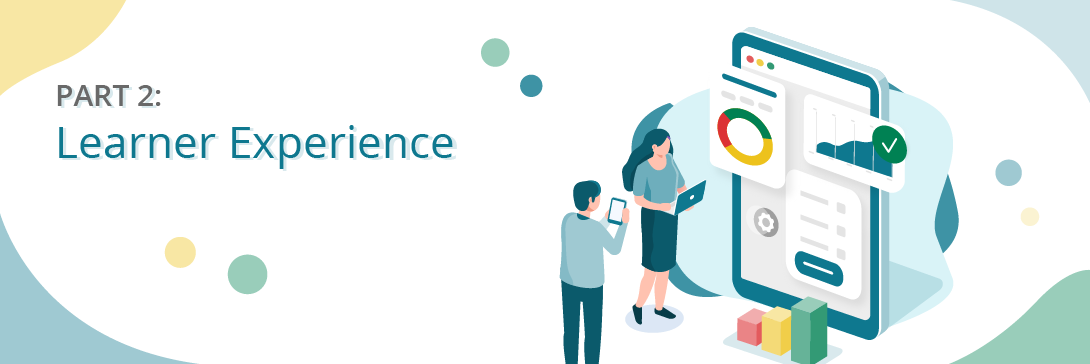3 Pillars for an Effective Learning Program (Part 2): Learner Experience
With lifelong learning being the new normal for today’s professionals, learning-focused organizations have a tremendous opportunity. By creating effective learning programs, these organizations can help more workers achieve their goals while bolstering their own ROI.
To do that, organizations need a unified strategy that addresses both learner and organizational needs. Too many credentialing bodies, associations, and training companies are still relying on outdated programs that create learner frustration, candidate dropouts, and lost revenue. Forward-thinking organizations can differentiate themselves as demand grows across the marketplace by focusing on three essential pillars.
In our last blog post, we shared the first pillar of an effective learning program: learner engagement. For organizations, engagement is key for improving persistence during lengthy candidate journeys, forming long-term relationships with professionals throughout their careers, and driving incremental revenue. But how do you get there? With programs that start with the needs of the learner.
Here, we share a closer look at the second learning program pillar: learner experience.
The learner's experience is Everything
Imagine you’re a human resources or IT professional studying for an advanced certification. You want to do well on the exam, but between putting in hours at your day job and keeping up with your kids, uninterrupted study time is hard to come by. You need a program that works around your schedule, is tailored to your skill level, and makes it clear what you’ve already mastered and where you still need to focus.

Creating this type of enjoyable, effective, and efficient learning experience is a common goal among learning organizations. For those that succeed, the benefits can be big. A great learning experience results in more engaged learners, helping them retain more of what they learn and supporting their success on exam day and on the job. Engagement is good for organizations as well, helping to improve candidate persistency, encouraging learners to come back for additional courses, and boosting the bottom line.
Yet many programs are falling short of these goals. Most of today’s courses take a one-size-fits-all approach without offering learners material personalized to their unique needs, the ability to study on the go, or insight into their overall progress. Traditional learning management systems are the major culprit behind this one-size-fits-all approach. These systems tend to focus on managing learning activities and don’t meet learner expectations, resulting in a big gap between learners’ needs and reality. Most learning management systems options typically offer limited configurations, while building a solution from scratch is an onerous and expensive task.
That’s why many organizations are seeking a more modern, user-focused way to deliver learning. According to a Brandon Hall Group study, improving the learner experience is the number one reason organizations switch learning management system providers.
3 steps for improving the learner experience
Building an effective learning program means being able to deliver a great experience to every learner, every time, at scale. Since each learner is on a different path, organizations are increasingly turning to digital solutions that allow them to provide highly personalized, engaging lessons. To improve the learner experience at your organization, here are three key areas to keep in mind.
- Make it accessible. The average American spends 5 hours a day on their mobile phone. To connect with busy professionals, nearly half of organizations are already incorporating mobile learning into their programs. In addition to making learning accessible across devices, presenting lessons in bite-sized chunks allows learners to squeeze in a study session whenever they have a few minutes.
- Make it personalized. Remember those busy HR and IT professionals pursuing their next certifications? They might learn best by scanning through flashcards every night, while their colleagues enjoy bouncing questions off of other program users when absorbing new concepts. The best programs provide a personalized experience based on each learner’s preferences and knowledge across a variety of areas.
- Make it smarter. Actionable data – for both the learner and the organization – is key for creating a better learning experience. By providing real-time feedback on overall progress, specific strengths and weaknesses, and more, digital learning programs can help professionals spend their time wisely and keep them motivated throughout the candidate journey. The most powerful insights come at the organizational level, however. By understanding how users are performing on specific questions or sections and where candidates are dropping out, businesses can identify larger trends and opportunities to optimize the learner experience.
Today’s learners have high expectations, and organizations that can meet those demands will lead the way into the next wave of professional education. By making learning more accessible, personalized, and insightful, businesses can build programs that boost learner engagement and organizational success.
Learner experience has received a lot of attention at HR Certification Institute® (HRCI®), which supports professional advancement by developing and administering best-in-class certifications for human resources professionals. With a focus on improving the candidate journey, HRCI set out to provide better resources to help learners feel more prepared when exam day arrived.
While learner engagement and learner experience are essential for any program, there’s one final ingredient required to achieve long-term success. Click here for part three of our series and the third pillar of an effective learning program strategy: organizational revenue.





